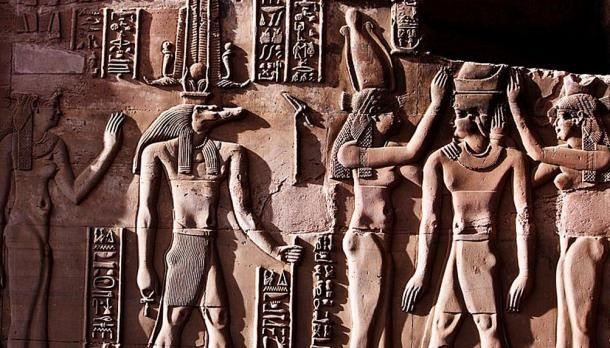
Kom Ombo is an ancient Egyptian town located in the Aswan Governorate of Upper Egypt, about 50 km (31 miles) to the north of Aswan. It is famous for its magnificent temple, which is unique because it is dedicated to two rival gods – Sobek and Horus.
The Temple of Kom Ombo was constructed during the Ptolemaic dynasty, beginning under Ptolemy VI Philometor in 180 BC and finishing under Ptolemy XII Neos in 47 BC. The most striking aspect of the Temple of Kom Ombo is the fact that it was dedicated to two Egyptian gods , Sobek the crocodile-headed god and Horus the falcon-headed god.
The ancient Egyptians believed that Sobek and Set were allies during the latter conflict with Horus. After the defeat of Set, his allies changed into crocodiles in order to escape from Horus. In other words, Sobek and Horus were enemies. Nevertheless, both gods are honored at the Temple of Kom Ombo.

This relief from the Temple of Kom Ombo shows Sobek with typical attributes of kingship, including a was-sceptre and royal kilt (Hedwig Storch / CC BY-SA 3.0 )
The structure of the temple is unusual because of its ‘double design’. The Temple of Kom Ombo is divided symmetrically into two parts along a main axis. The western side of the temple was dedicated to Haroeris (the ‘Great Horus’, or ‘Horus the Elder’), while its eastern side to Sobek. Each half of the temple consisted of a monumental gateway, a hypostyle forecourt (which are linked), and an inner sanctuary for the deity.
Eventually, the Temple of Kom Ombo fell into ruin, damaged by Nile flooding, earthquakes, and builders who used its stones for other projects. It was only during the late 19th century that the temple received attention from Western archaeologists, who had the temple restored.
More than 300 crocodile mummies have been found in the vicinity of the Temple. They were most likely left as offerings to Sobek.
Read more about the Temple of Kom Ombo
Top image: Kom Ombo Temple. Source: Alfredo / Adobe Stock






